The objective of this 4-yr study was to determine species composition and abundance of stink bugs (Heteroptera: Pentatomidae) and a leaffooted bug (Hemiptera: Coreidae) and their predators in sorghum [Sorghum bicolor (L.) Moench spp. bicolor] in Georgia. Nezara viridula (L.) was the predominant species in sorghum; density of this stink bug was twice as high as that of the second most abundant stink bug, Oebalus pugnax pugnax (F.). Euschistus servus (Say) was the third most abundant stink bug species. Density of both Leptoglossus phyllopus (L.) and Euschistus quadrator (Rolston) was about half that of E. servus. Chinavia hilaris (Say), Thyanta custator custator (F.), Euschistus tristigmus (Say), Euschistus ictericus (L.), and Piezodorus guildinii (Westwood) were minor pests in sorghum. Adult bugs primarily fed on developing seed. For all bug species, except E. tristigmus and E. ictericus, sorghum served as a reproductive host plant. In order of descending overall abundance, bug predators present in sorghum were Orius insidiosus (Say), Geocoris spp. [Geocoris punctipes (Say) and G. uliginosus (Say)], lady beetle species, i.e., Hippodamia convergens Guerin-Meneville, Coccinella septempunctata (L.), Coleomegilla maculata (De Geer), and Harmonia axyridis (Pallas), spiders, i.e., Peucetia viridans (Hentz), Oxyopes salticus Hentz, and spiders in the Salticidae and Thomisidae families, Solenopsis invicta Buren, Podisus maculiventris (Say), Sinea diadema (F.), and Nabis spp. Conserving these natural enemies of panicle-feeding bugs in sorghum could possibly be used in management of these bugs in southeastern farmscapes.
BioOne.org will be down briefly for maintenance on 17 December 2024 between 18:00-22:00 Pacific Time US. We apologize for any inconvenience.
How to translate text using browser tools
1 January 2013
Stink Bugs (Heteroptera: Pentatomidae), a Leaffooted Bug (Hemiptera: Coreidae), and their Predators in Sorghum in Georgia
P. Glynn Tillman
ACCESS THE FULL ARTICLE





